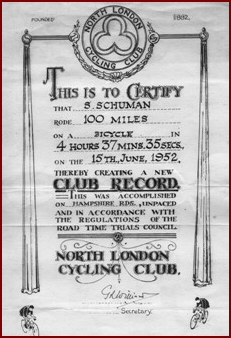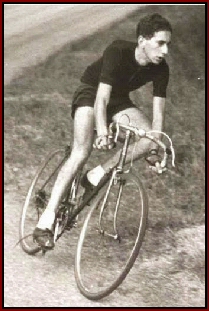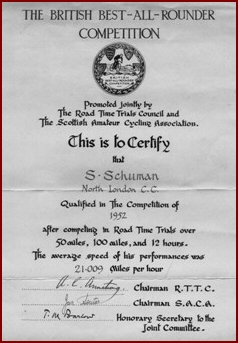


Sidney cycling - my story
I got my first bike when I was 11; it had 24" wheels, a single freewheel and rod brakes. Soon the 24" wheels became inadequate - I needed a bigger bike. So dad took me along in 1944 to one of the James Grose cycle shops, in Euston Road. All the bikes on offer were "utility" bikes - no chrome, all black enamel, very inferior quality metal. I was determined to have dropped handlebars (with cable brakes) and so I got my first sports bike. It had 3 gears and cost £12.
In 1945 I was in my second year at Hackney Technical Institute learning about electricity. Wondering what to do in the the summer holiday, I got the idea of a four-week tour round the south coast. I put a notice up to see if anyone else was interested and three others said they would like to come with me. So I booked youth hostels about 35 miles apart for the whole trip and off we went. The route was London to Bath, then down to Barnstaple and along the north Somerset coast, making sure we rode up Porlock Hill. Then all the way along the north coast of the Devon/Cornwall peninsula to Lands End. From there we rode along the entire south coast, making sure we crossed over to the Isle of Wight. and at Margate we turned back to London. During the four weeks we rode about 1000 miles and used Bartholomews half-inch maps to keep the arguments going. In 1946 I started to go on longer and longer rides. Brighton and back, Oxford and back, Bath and back, etc. One day I ventured out at 5:30 am, had breakfast in Eastbourne, lunch in Portsmouth and tea in Ripley. 240 miles and I felt just fine after a few days in bed.
I joined the Clarion CC in 1947 entering the magical world of Sunday club runs and eventually I started time-trialling. To begin with I just beat 'evens' (20 mph) and did 1-12 for a 25 and 2-26 for a 50. But then I started to get the idea (oh I see, you actually have to try) and got down to 1-5 for a 25. I was a typical middle-marker, not very fast but not very slow either. My best ride was an open 50 on the A11. On the day (some time early in 1950) there was a strong northeast wind blowing. I was using a gear a bit lower than most of the other riders, and got to the halfway turn comfortably in 1-10. The second half with a tailwind was crazy, with me just letting my legs go round as fast as possible, passing everyone and giving me a time of 2-12. I must have been flying because when I finished someone asked me what gear I was using - that's why I remember it was 79 (46 x 15 on 26" wheels). My 14-minute improvement earned me the First Handicap prize. Can't remember what it was, probably a puncture outfit. My Clarion friend Sid Kenton was always trying to go one better than me and on a float morning on a dead flat 25 course in Norfolk he did a 1-2 while my best stayed at 1-5 (the irony was not lost on me that my best 25 equalled his but was the second half of a 50 mile time trial).
About this time I met Dennis Fleming on the daily massed-start race from the gates of BTH in Willesden, where we were both apprenticed. After a few times climbing Telegraph Hill up to Jack Straw's Castle on Hampstead Heath, he suggested I join the North London CC. This was a proper racing club and I took to it like a duck takes to water. On one of the first rides, to Brighton and back, we had an unofficial race up Handcross Hill with the Southern Elite CC. As Del Rolt said, we got the team prize - Del, Fred Hope and me. On an Easter Tour to Wales we were riding up a steep hill. All the others were out the saddle but I was busy perfecting my ' hill, what hill? ' style. This was too much for Tony Gregory who gave it as his opinion that the reason I was still on my saddle was that I had shit myself. Life with th North London ws full of such delicate experiences. As for time trials, I was never able to improve my best times at 25 and 50 miles, although I came close in a club 50 in 1951. Clive Chamberlain had caught me and we rode side by side for awhile. Then ten miles from the finish I made my legs go round faster and dropped him. Unfortunately a few miles up the road I went over the top (don't ask) and finished in hospital so I'll never know what time I might have done.
I started to ride 100s and again I was just inside evens with a time of 4-50 in the club 100, but in June 1952 I tried a bit harder in a Wessex open 100 and did a 4-37. In another open 100 on the Bath Road I had the bizzarre experience of passing the great Vic Gibbons. He had just whizzed past me and, using gears for the first time, the air was blue as he struggled to get them working up the next hill. Naturally I seized my chance of fame, which was very brief as Vic sorted his gears out and of course I never saw him again.
To be considered for the club (or national) best all rounder championship you had to ride a 12-hour time trial. The interesting part of this is at the end, as there s no possibility of a finish line. After riding the course around the local counties, a finishing circuit is provided where you are followed by a riding marshal who tells you when your time is up. Then, back at the start, you find out how far you went - in my case ususally between 220 and 230 miles. In those days only the fast men could do evens for that long.
1952 was a busy year for me. Not only did I gain a Higher National Certificate in electrical engineering but I also became club champion of the North London Cycling Club, mainly on the basis of the 4-37 in the Wessex 100. My 2-12 for the 50-mile and 224 miles for the 12-hour went towards a 21mph average. This was enough to win the club championship and get me on to the RTTC British Best All Rounder list.
 |
 |
 |
Next year while I was in the RAF (1953 - 1954) I won a massed-start race at Stapleford Tawney aerodrome for the selection of a team to go to the Maccabiah (Jewish Olympics). I was not granted leave to go to Israel, for which I am truly thankful. I kept up with my time-trialling and did a 2-10 for a 50. However, by demob time the spark had gone. A club 100 in 1955 saw me falling off my bike at the finish, not because I'd gone particularly fast but because I was just knackered. The following year saw me losing touch with the North London CC as life intruded and club riding with the CTC became my main cycling activity. My racing career died the death and I was not to ride another time trial until 60 years later, when having noticed that no-one over 80 had ridden the UCI best performance age-related hour, I had a go and set a new world record. My cycling career came to an abrupt end with a pothole accident just before my 90th birthday. Now I ride a recumbent exercise bike to the accompaniment of music from my classical collection..